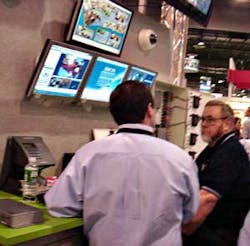DVTel Makes Its Way into Access Control
DVTel, a five-and-a-half-year-old company that's been focused on IP video, announced at ISC West that the company was making its first major play into IP-based access control.
The company's digital video platforms (the company also deals in IP cameras -- both fixed and PTZ domes) haven't been a stranger to access control. Paul Smith, COO of DVTel says the company has worked to integrate its digital video management systems with companies like Lenel and others. Integrating the DVTel video systems with access control wasn't a rare occurrence either; Smith adds the company has worked up integration links with 14 of the industry's top access control systems, and had used those integration interfaces on a very regular basis.
But despite its success integrating with existing access control system, DVTel was still a company focused on digital video. Thus, it came as a bit of a surprise at ISC West when a portion of the DVTel booth was dedicated to new acquisition SAI Inc., a family-owned access control system vendor from Fishkill, N.Y. The SAI system, despite having just a slightly-bigger-than-regional foothold in the market, brought DVTel a full feature set. It could handle access, visitor management, badging, alarm monitoring and even time and attendance. It was a system that had quietly made a sizable footprint, having been installed in some 4,000 different Verizon equipment offices, to name its most prominent customer.
Despite the company's success with integrating to existing access control systems, something Smith stresses that DVTel will more than happily continue to do in the future, Smith said that the company's philosophy and desire to see full integration pushed them toward the access control acquisition.
"We felt we could really do well if we had a company to tie together with on access control for iSOC," said Smith. The iSOC is the company's "intelligent Security Operations Center" platform, which merges control over video, audio, access control, visitor management, credential creation, analytics and alarm monitoring.
So about a year ago, DVTel started quietly shopping for an access control system provider. The goal, as Smith says, was to link all the video data with the access control and alarm monitoring data to give rich information from a total security system. On their list of "wants" were two chief requirements. The first was that the access control platform must meet DVTel's network/IP-centric philosophy. Secondly, says Bruce Doneff, who handles the company's public relations, they were looking for a company that was hardware agnostic.
He explains what that means, saying that DVTel had always been focused on making sure that its system would work with as many hardware companies as possible so that almost any edge device (a camera, or video encoder, for example) would work with the system. Even though the company sells its own cameras, they didn't try to pigeon-hole buyers to solely use DVTel hardware. Doneff says they found that same philosophy in SAI, which, thanks to a long list of SDKs and APIs, could work with a variety of access control panels and edge devices, such as Hirsch, HID's VertX, Lenel, NexWatch, Checkpoint (now Sielox), Northern, Apollo, Mercury and others.
As the companies move forward they're quickly merging under the DVTel umbrella. Smith explains that they've already positioned the DVTel video platform as the Latitude NVMS (network video management system), and the SAI access control system is being branded as the DVTel Longitude. They've begun integrating the systems closely -- merging log-ins and creating a shared rights/privileges tool for users. As of now, each software system -- the DVTel video and the SAI access -- has its own database. While the companies now easily pipe and share data between the two databases to achieve the benefits of integration, Smith says those will likely link together into one more robust database in the future.
For now, says Smith, the relationship between the DVTel software and SAI system is a lot like the Microsoft Office suite of programs, where data can move seamlessly from MS Word to Powerpoint to Excel and elsewhere. A door opens and the video links to it. Cameras are synched with an intrusion alarm. A card is used and the video system can zoom in to tell the monitoring agent whether it's actually Joe Smith or whether it's someone who has borrowed or stolen his access card. The possibilities, says Smith, are almost endless, especially as the video and access data start to live on an IP-standardized system.
DVTel and its new access control acquisition can be found online at www.dvtel.com.
